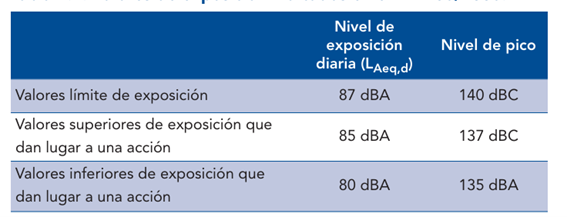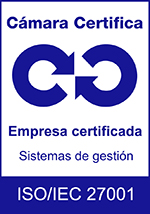The National Institute for Safety and Health at Work (INSST) has published a comprehensive updated guide on risk assessment for noise exposure, stressing the importance of a comprehensive ergonomic assessment to mitigate both the auditory and non-auditory effects of noise in the workplace. This document, entitled ‘Ergonomic Aspects of Noise 2024’, sets out precise guidelines for addressing and managing noise in work environments, reinforcing the need for an approach beyond the limits set by Royal Decree 286/2006.
Exposure values indicated in RD 286/2006.

Source: ERGONOMIC ASPECTS OF NOISE 2024. Ministry of Labour and Social Economy.
Royal Decree 286/2006, which sets noise exposure limits to prevent hearing damage, remains an essential reference. However, INSST points out that compliance with these limits does not guarantee protection against non-auditory risks, such as the impact on workers’ concentration, communication and general well-being. In this context, the new INSST guidance extends the assessment approach to include these additional ergonomic aspects:
Impact on communication
Excessive noise can make verbal communication between employees difficult, affecting coordination and work efficiency. The INSST guidance suggests assessing how noise interferes with normal conversations and emergency communication systems. The recommendation is to incorporate methods to measure speech intelligibility in different work areas and assess the risk of misunderstandings that could compromise safety and operational efficiency.
Effects on concentration and performance
Continuous exposure to high noise levels can reduce the ability to concentrate and increase stress, which negatively impacts work performance. The guidance advises conducting studies to assess how noise affects workers’ cognitive ability, information processing speed and task performance accuracy. These studies may include noise perception surveys and analysis of performance on specific tasks in the presence of different noise levels.
General welfare of workers
Noise can also influence the general well-being of employees, causing fatigue, irritability and sleep disorders. The new guidance recommends conducting work climate surveys to assess the impact of noise on workers’ satisfaction and well-being. It also suggests implementing assessments of work-related stress and the impact of noise on mental and physical health, using questionnaires and interviews.
Evaluation of ergonomic aspects
The guidance emphasises the need to consider ergonomic aspects in the risk assessment of noise exposure. This includes analysing how noise affects the ergonomics of the workplace, such as the layout of workstations and equipment, and its influence on the comfort and efficiency of the working environment. An ergonomic assessment of the workspace is recommended to identify possible design improvements that can reduce the impact of noise.
Control and mitigation measures
Based on this comprehensive assessment, the INSST guidance suggests developing a noise control plan that not only focuses on reducing noise levels, but also on improving ergonomic aspects and well-being. This may include the installation of noise barriers, the use of appropriate hearing protection equipment, the optimisation of workplace design and the implementation of work practices that minimise the impact of noise on communication and concentration.
At Laragon/ALL4 we offer software solutions that are perfectly aligned with INSST recommendations. Our Incident Management Software allows you to record and analyse incidents related to noise, among others, facilitating a quick and effective response. The Risk Analysis and Occupational Safety Software helps to assess noise-related risks and implement mitigation strategies based on accurate data. In addition, Industrial Hygiene Software facilitates the monitoring and control of noise levels in the work environment, ensuring compliance with regulatory requirements and improving hearing safety. With these tools, companies can comply with the new INSST guidelines, promoting a culture of safety and improving the management of noise-related risks in the workplace.



